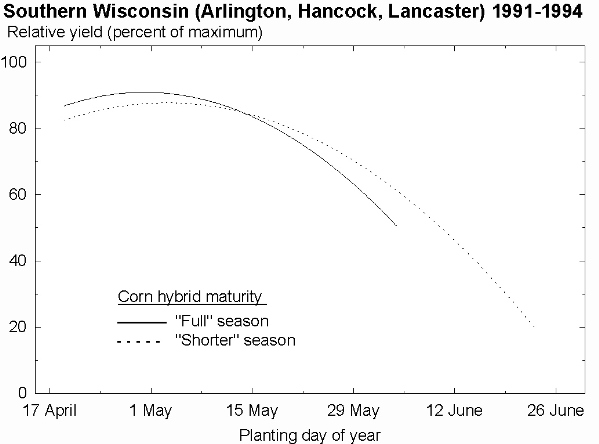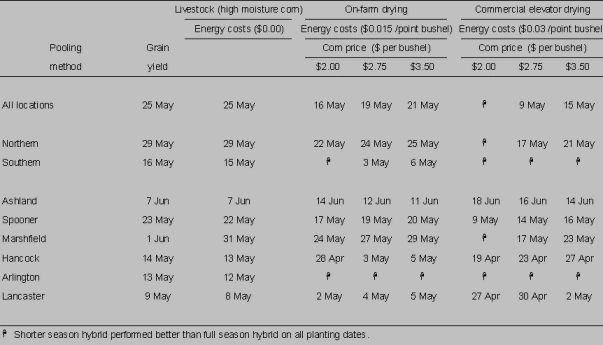When Do We "Switch" from Full-season to Shorter-season Corn Hybrids?
May 9, 1996 3(8):53-54
Joe Lauer, Corn Agronomist
On average, the best time to plant corn in most of Wisconsin is from 20 April to
10 May. The optimum date is around 1 May, but it will vary from year to year. To
finish planting by 10 May is a goal most farmers should work toward. In northern
Wisconsin, the optimum planting period may be 7 to 10 days later.
The rainy, cold weather and wet, cool soil temperatures we have experienced during
April and early May has delayed Wisconsin fieldwork this year. Due to delayed planting,
it is likely that some growers will need to modify their hybrid selections and switch
corn hybrid maturities from full-season to shorter-season maturities. A full-season
hybrid is defined as a hybrid that uses (or requires) the entire available growing
season to reach physiological maturity before killing frost or cool temperatures
end the growing season.

Corn producers need to select hybrids that yield well for their maturity. Delayed
planting will affect both yield potential and grain moisture at harvest. Full-season
hybrids are more affected by delays in planting than shorter-season hybrids. Usually
there is some date during the growing season when shorter-season hybrids perform
better than full-season hybrids (Fig. 1). The date when the performance of the full-season
hybrid equals the shorter-season hybrid would be considered the "switch"
date. In the example in Fig. 1 using yield as the performance measurement, the hybrids
should be switched on 13 May.
A four year trial conducted at six locations in Wisconsin between 1991 and 1994
investigated the relationship between corn performance and planting date. One objective
of this trial was to determine when hybrids should be switched from full- to shorter-season
maturity. In this trial, maturity differences between full- and shorter-season hybrids
ranged between 5 and 15 days based upon the Minnesota Relative Maturity System depending
upon location.
An important aspect of the decision to "switch" hybrids should be the
potential use of corn and the "yield versus grain moisture trade-off."
Using the data from the 1991 to 1994 study period, I calculated grower return for
three corn production systems: livestock (ear corn and high moisture corn), on-farm
drying and commercial elevator drying. Grower return is the amount of money left
over after treatment costs have been subtracted, which in this example is mostly
energy costs for drying. For these scenarios I also subtracted hauling and handling
costs of $0.04 and $0.017 per bushel since it costs more to handle higher yields.
Table 1. Date to "switch" corn hybrids from full- to shorter-season
relative maturity in three corn production systems.

The "switch" dates were affected by corn production system. In general,
switching between full- and shorter-season corn hybrids grown for livestock and
not requiring any energy costs for drying was later than the other production systems
where drying costs were necessary (Table 1). Later switch dates were seen with higher
corn prices in both on-farm drying and commercial elevator drying corn production
systems. Earlier switch dates were seen with increasing energy costs for drying.
An exception was at Ashland that might be modified somewhat by the "lake effect."
At Arlington, the shorter-season hybrid returned more than the longer season hybrid
on every planting date indicating that there are some shorter-season hybrids which
approach the performance of full-season hybrids and since they are drier at harvest
may have greater grower return.
Table 2 describes some guidelines for switching corn hybrid maturities in various
Wisconsin production zones when the end-use is dry grain. The chances of obtaining
dry grain when planting in mid- to late-June are low. When using these guidelines,
please remember that growing season, site and management influence a particular
hybrid's actual days to maturity. Maturities listed are estimates based on the
Minnesota Relative Maturity System. This is a widely used system, however, not all
companies use this exact day maturity system and there is no industry standard for
estimating maturity. Therefore, use the values in Table 2 only as a general guide.
|
Table 2. Latest acceptable planting date and hybrid maturity for dry corn grain in
several Wisconsin production zones.
|
|
Hybrid maturity
|
Southern
|
South Central
|
North central
|
Northern
|
|
Latest planting
|
Relative maturity
|
Latest planting
|
Relative maturity
|
Latest planting
|
Relative maturity
|
Latest planting
|
Relative maturity
|
|
|
date
|
days
|
date
|
days
|
date
|
days
|
date
|
days
|
|
Full-season
|
5 May
|
105-110
|
8 May
|
100-105
|
11 May
|
95-100
|
14 May
|
85-90
|
|
Mid-season
|
15 May
|
100-105
|
18 May
|
95-100
|
21 May
|
85-95
|
24 May
|
75-85
|
|
Short-season
|
25 May
|
95-100
|
28 May
|
90-95
|
31 May
|
75-85
|
4 June
|
65-75
|
Although the penalty for late planting is important, growers also need to be careful
to avoid tillage when soil is too wet. Yields may be reduced somewhat this year,
but effects of soil compaction can reduce yields for several years to come. Your
decision to switch hybrid maturity depends upon:
-
Desire to accept risk: Longer season hybrids offer the highest yield potentials,
but may also increase drying costs and/or delay harvest.
-
Potential use: For dry grain, relative maturities should be shorter-season
within the maturity range for the latest acceptable planting date. For ear corn,
high moisture corn, and silage, relative maturities should be longer-season within
the maturity range for the latest acceptable planting date.
-
Field conditions: Shorter-season hybrids within the maturity range for the
latest acceptable planting date should be selected when field conditions include
heavy crop residue, reduced tillage, and heavy soil textures.
-
Hybrid dry down and grain quality characteristics: Longer-season hybrids
within the latest acceptable planting dates should have fast grain dry-down and
high test weight characteristics.
-
Ease of trading original hybrids for superior shorter-season alternatives.